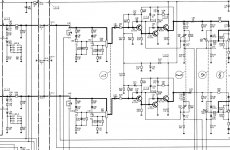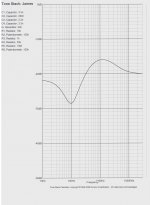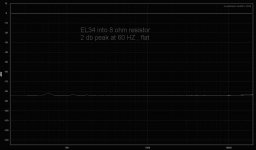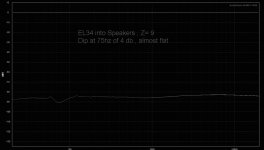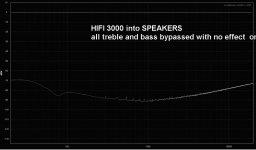I had to check and measure a sample pot I have. Alps 50KAX2 (LOG POT). At left most position (-12dB bass attenuation) the center wiper is shorted to the left pin. At middle position (it is a 10 position pot) the left pin is 10K from the wiper. In this case (if log pot is used), the treble and bass are attenuated not boosted...
I checked a linear pot (B100K), which is rare so it is a cheap one...
The total resistance is 77k2. At center position it is 38k9, which is more than 50%...
Tried the other channel, total=80k, at center position it is 38k2, which is less than 50%... WTF!!!!
That is exactly what I was referring to.
Mike
I know that Jay,
SO the logic for the manufacturer is to insert that POT in the side that BOOST the high and low signals.
I will bypass the tone controls and measure again the amp.
SO the logic for the manufacturer is to insert that POT in the side that BOOST the high and low signals.
I will bypass the tone controls and measure again the amp.
You should have done this 102 posts ago. 😉I will bypass the tone controls and measure again the amp.
Attached is a fragment of TR-500 schematic. You can clearly see the "loudness" circuit around the volume pot, shown in "on" position.
The curve in Post #1 shows the "loudness on" FR with very high probability.
That simple.
The curve in Post #1 shows the "loudness on" FR with very high probability.
That simple.
Attachments
Ok, sorry guys, I got carried away a bit - I'll try to put on my serious hat  .
.
Has anyone even looked at the schematics of the Telefunken TR350? The volume pot has two taps, each with its own separate loudness circuit. The tone control circuit design seem to have a lot to be desired - if a flat response is the goal. A simplified simulation gives a -9/+4 dB response at 100 and 1kHz respectively in pot mid-point setting.
That also leaves a plethora of mechanical switches, contacts and wipers in the audio path to be dusty, oxidised or faulty - to eventually produce the strange measured FR. The non-analogue type response drops shown in post no1 should really have raised that issue.
In any case, there is absolutely no justification whatsoever for claiming a global hi-fi amplifier "voicing" conspiracy - at least not based on this obviously quite tired old Telefunken amp.
And i must say that it is sadly impressive that it took over 90 posts to finally get to know which amp we were talking about.
Just my serious 2p.
 .
.Has anyone even looked at the schematics of the Telefunken TR350? The volume pot has two taps, each with its own separate loudness circuit. The tone control circuit design seem to have a lot to be desired - if a flat response is the goal. A simplified simulation gives a -9/+4 dB response at 100 and 1kHz respectively in pot mid-point setting.
That also leaves a plethora of mechanical switches, contacts and wipers in the audio path to be dusty, oxidised or faulty - to eventually produce the strange measured FR. The non-analogue type response drops shown in post no1 should really have raised that issue.
In any case, there is absolutely no justification whatsoever for claiming a global hi-fi amplifier "voicing" conspiracy - at least not based on this obviously quite tired old Telefunken amp.
And i must say that it is sadly impressive that it took over 90 posts to finally get to know which amp we were talking about.
Just my serious 2p.
Sorry.In any case, there is absolutely no justification whatsoever for claiming a global hi-fi amplifier "voicing" conspiracy - at least not based on this obviously quite tired old Telefunken amp.
Just my serious 2p.
don't you have residual doubts in your mind after seeing the schematic?
I will bypass and keep you posted, hope you don't lose interest too soon.
So the power amp had better specs than the preamp section? Something doesn't seem right with that
Aha, using EQ to make good response trying to trick customers to buy there amp, resulting in increced distorn in preamplification lol 😀
Sorry.
don't you have residual doubts in your mind after seeing the schematic?
I will bypass and keep you posted, hope you don't lose interest too soon.
Well, please see the attached sim of the tone control.
If that is an attempt to make the amp sound better, the designer probably had a few schnitzelgruben too many!
Attachments
omg this is getting worse
See attachment, tests were done with a 6 DB feedback 5K loading EL34 , surprisingly good for such low feedback, the HIFI3000 got a lot worse off with the tone controls bypassed with no effect at their relative position.
To sum up in one word: SICK
See attachment, tests were done with a 6 DB feedback 5K loading EL34 , surprisingly good for such low feedback, the HIFI3000 got a lot worse off with the tone controls bypassed with no effect at their relative position.
To sum up in one word: SICK
Attachments
You know, I think that it is now obviously clear that you also have seriously overdosed on schnitzelgrubens.
"To sum up in one word: SICK"
Dead right mate, I'm out of here!
"To sum up in one word: SICK"
Dead right mate, I'm out of here!
Performance that bad doesn't come cheap.
Around here my cheapness makes all sorts of amplifiers with terrible specs😛
They are like ugly children, you kinda love them a little more.
I quite like that response curve, my ears enjoy some loudness contouring.
I can't stop giggling at this. Everyone is bitching about this that or the other on this thread, and here's Bigun saying, "What's the problem?" 😀
I am with Bigun!!
See attachment, tests were done with a 6 DB feedback 5K loading EL34 , surprisingly good for such low feedback, the HIFI3000 got a lot worse off with the tone controls bypassed with no effect at their relative position.
To sum up in one word: SICK
What's a "HIFI3000", tried to Google and only found a HiFi retailer.
And you still haven't answered my questions.
Mike
HR 3000 , burn it and burn this forum thread. Bye Michael
So if you won't back up your claims with relevant info and data, all you have is claims.
Over and out.
Mike
If the amp is tracking the speaker impedance because of a high output impedance which has been proposed maybe measuring the output impedance is the next step. If it indeed measure high then we can all sleep better tonight.
As mentioned Bob Carver used to add some output resistance to get a tube sound from SS. Do we have a schematic of the Telefunken amp in question?
As mentioned Bob Carver used to add some output resistance to get a tube sound from SS. Do we have a schematic of the Telefunken amp in question?
I haven't ever measured an amp or CD player that was that tilted.
Hmm, maybe not a CD player, but I've had some time wasted by a very expensive assumed-to-be-high-performance DAC made to "fix" the "pre-ringing" problem of "digital" (it took a while before I found out about that part). A customer was trying to use said DAC with speaker measurement software of mine that utilized the (usually) reliably decent frequency response of CD players. He was seeing the HF response quite a few dB down on all measurements, so we went around for some days and a number of emails trying to find out what the problem was. It turned out to be the "fixed" DAC. Funny thing, you change the impulse response of a converter, it tends to also change (i.e., screw up) the frequency response too!
After this thread which obliged me to show 5 pictures of the burst tone response and some posters don't see how the response is bad...
First of all, disabling the tone control made the amp response curve a lot WORSE.
I can't see the feedback in the schematic and it is a capacitor output, very bad for a power amp.
The output have some network of resistors and filters to stop the amp from oscillating, which obviously don't work, since removing a transistor sensing input cap made the amp permanently catch some radio signal, I can fix it but it doesn't had an effect on the sound.
http://www.amplificateurslegrand.ca/hfe_telefunken_hr_3000_service_en_de_fr.pdf
this is the manual in question,
Now I will preheat my tubes before listening to any music for at least an hour. 😡
First of all, disabling the tone control made the amp response curve a lot WORSE.
I can't see the feedback in the schematic and it is a capacitor output, very bad for a power amp.
The output have some network of resistors and filters to stop the amp from oscillating, which obviously don't work, since removing a transistor sensing input cap made the amp permanently catch some radio signal, I can fix it but it doesn't had an effect on the sound.
http://www.amplificateurslegrand.ca/hfe_telefunken_hr_3000_service_en_de_fr.pdf
this is the manual in question,
Now I will preheat my tubes before listening to any music for at least an hour. 😡
Wouldn't that 2200uF output cap and the 1.3mH woofer inductor in my passive xo create a resonance around 100Hz?
I know you don't have the same speakers as me but maybe you are seeing something similar?
I know you don't have the same speakers as me but maybe you are seeing something similar?
After this thread which obliged me to show 5 pictures of the burst tone response and some posters don't see how the response is bad...
First of all, disabling the tone control made the amp response curve a lot WORSE.
I can't see the feedback in the schematic and it is a capacitor output, very bad for a power amp.
The output have some network of resistors and filters to stop the amp from oscillating, which obviously don't work, since removing a transistor sensing input cap made the amp permanently catch some radio signal, I can fix it but it doesn't had an effect on the sound.
http://www.amplificateurslegrand.ca/hfe_telefunken_hr_3000_service_en_de_fr.pdf
this is the manual in question,
Now I will preheat my tubes before listening to any music for at least an hour. 😡
Did you bypass the volume pot?
HR 3000 has got the "loudness" compensation "always on" and your frequency response curves look very much like "corrected" by "loudness" network.
huh no because I need to volume pot,
Anyway I think we put the finger on the problems:
1. Permanent loudness filter at the volume pot
2. Treble and Bass filters
SO to answer my claim : yes this company cheated the sound on the whole range of their amplifiers.
Anyway I think we put the finger on the problems:
1. Permanent loudness filter at the volume pot
2. Treble and Bass filters
SO to answer my claim : yes this company cheated the sound on the whole range of their amplifiers.
- Status
- Not open for further replies.
- Home
- Member Areas
- The Lounge
- How to sell amplifiers (cheat the sound)
